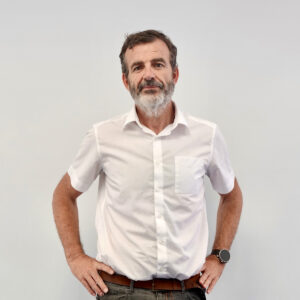
Carlos Pardo has a distinguished career as a manager in the microelectronics industry, excelling in leading R&D teams. He possesses extensive expertise in the high-tech silicon sector, encompassing both hardware and software development. Previously, he served as the Technical Director at SIDSA, where he managed R&D departments, product development, production, and customer support, among other responsibilities. Mr. Pardo also contributed significantly at Hewlett Packard SA Spain as an R&D engineer, handling various business functions, and at DS2 (Design of Systems on Silicon SA).
Tell us about your company
Fabless semiconductor supplier KD provides innovative high-speed optical networking solutions for harsh environments. Founded in 2010 in Madrid, Spain, KD offers its cost-effective technology as fully qualified automotive-grade ASSP, integrating electronics, photonics, and optics in a single IC.
KD’s technology makes use of information theory, innovative digital adaptive algorithms, and analog mixed-signal design to maximize the receiver’s sensitivity. KD innovates in optical coupling and packaging design, which enables integration of optical communications ports in electronic control units using standard printed circuit assembly processes. Together, these offerings allow KD to support high-yield and reliable optoelectronics production in low-cost automotive-grade bulk CMOS deep submicron nodes, and to deliver products to carmakers with low risk, low cost, and short time-to-market.
KD made gigabit communications for step-index plastic optical fiber (SI-POF) a reality for automotive and is now developing its multi-gigabit optimized solution for use with Glass Optical Fiber (GOF) as well.
What problems are you solving?
Data transfer in harsh environments, such as vehicles, presents unique challenges compared to data center environments, including stringent environmental conditions, reliability demands, cost constraints, and high production volumes. These factors have prompted the development of specialized specifications for optical links tailored to automotive applications.
More and more, seamless connectivity of sensors, such as cameras, radar, and LiDAR with central Artificial Intelligence (AI) units, plays a key role in sensor fusion, an integral part of Advanced Driver Assistance Systems (ADAS) and Autonomous Vehicles (AV). Therefore, an optical solution is required as copper communications do not meet these needs.
Optical Ethernet connectivity perfectly solves in-vehicle challenges and electrical interference thanks to its unbeatable electromagnetic compatibility, reliability, and low cost. Fiber is inherently immune to electromagnetic interference and does not emit interference, thus saving an immense amount of additional development time and cost. Regarding temperature, fiber cables withstand extreme temperature ranges from -40 ºC up to +125 ºC for operation ambient. A simpler channel allows for a lower power consumption than copper, thanks to a simpler DSP/equalization and no need for echo cancelling.
For reliability and durability, the selection of the 980 nm wavelength allows VCSEL devices to comply with automotive reliability standards and lifetime. As no shielding is needed, connectors are smaller and mechanically more robust. In contrast to copper, up to 4 inline connectors for a speed of 25 Gb/s and 2 inline connectors for 50 Gb/s can be inserted over a length of 40 meters. With copper, it is only possible to insert 2 inline connectors with a maximum length of 11 meters and 25 Gb/s. In addition, the lower diameter of the OM3 fiber results in significant cost efficiency.
What application areas are your strongest?
KD provides semiconductors for high-speed optical networking for harsh environments. Applications in automotive, home, small and home offices (SOHO), and industrial benefit from KD’s future-proven system solutions for connectivity over fiber optics.
Automotive
Optical fiber technology enhances the automotive industry by improving data transmission speeds, reducing weight, and increasing reliability. It enables high-speed communication between vehicle systems and is immune to electromagnetic interference. Additionally, its lightweight nature improves fuel efficiency and performance. Optical fibers advance vehicle connectivity, safety, and efficiency. Automotive use cases include: communications backbone, smart antenna link, infotainment, Battery Management Systems (BMS), ADAS, cameras, radar, and displays.
Industrial
Optical fiber technology benefits the industrial sector with high-speed, reliable data transmission over long distances, immune to electromagnetic interference. This supports advanced automation, real-time monitoring, and control systems, enhancing operational efficiency. Their durability and low maintenance reduce downtime and operational costs, improving connectivity, safety, and efficiency in industrial applications.
Consumer
KD delivers non-visible 1 Gb/s optical wired connectivity for homes and SOHO. Plastic optical fiber is not electrically conductive and its cross section and bending radius allows its routing through in any duct or collocated next to any wire, even electrical cabling avoiding the use of expensive new ducts or visible trucking inside walls.
What does the competitive landscape look like and how do you differentiate?
Since 2014, with the launch of the first transceiver, KD has led high-speed optical communications for the automotive industry. At present, KD is the only company offering transceivers that comply with the Ethernet standard IEEE Std 802.3cz, which is the standard suitable for gigabit and multigigabit optical communications in automotive.
In addition, we’re evolving from being a fabless IC supplier to component assembly and testing of fully integrated optoelectronic components. We’re setting up a high-volume production site for semiconductors close to our headquarters in Tres Cantos, Spain.
What new features/technology are you working on?
Our R&D is working on two fields, all of them focused to produce high-volume low-cost single-component optical multigigabit automotive transceivers. The first field is the integration of all the electronics – i.e. optoelectronics, analog and mixed signal, digital signal processing, high speed digital interfaces, microprocessors, dependability monitors, etc. – in a single die made in an automotive-qualified bulk CMOS process.
The second field is the development of hybrid packages that can be produced in automated way, where the CMOS die is integrated with VCSEL die, PIN PD die, optical lenses, and mechanical interface that accept the optical fiber ferrules. This hybrid package is very innovative, because it requires of high precision positioning of photonics and lenses, in short cycle times, and all the materials and assembly recipes must be chosen to support reflow temperatures without affecting performance degradation.
In addition, we’re developing a new and innovative optoelectronics packaging technology. It will be applied for the first time to produce the new transceiver IC KD7251 for high-speed automotive optical communications. In setting up several automated pilot plastic packaging lines for optical transceivers, we’re working with other companies on the automated line. The aim is to develop fully automated lines from the wafer, with dicing and backgrinding, with automated transfer between machines and high precision automated alignment in plastic packaging. At this time, we’ve installed a prototype line starting its first prototype assemblies. The final production line with high volume capacity is planned to start production in 2026.
How do customers normally engage with your company?
In the ecosystem with key industry partners, we provide a system solution for optical in-vehicle data transfer. Instead of various port components, customers benefit from the single, complete package.
Gigabit Integrated FOT
For 1 Gb/s optical communications over POF, the integrated KD9351 Fiber Optic Transceiver (FOT), in combination with the proven KD1053 IC, reduces the cost for optical in-vehicle networks at 1 Gb/s, compared to STP (shielded twisted pair of copper wires). Incorporating the transmit and receive optoelectronics into one single component, the KD9351 is an optical transceiver for 100 Mb/s up to 1 Gb/s with a small footprint, enhanced efficiency and flexibility.
Multigigabit Transceiver
The KD7251 is KD’s new ASIC that implements the BASE-AU physical layers, compliant with the IEEE Std 802.3cz™ specification for automotive multigigabit optical communications links over multi-mode glass optical fiber OM3. It‘s a single-chip solution with on-chip optical interface, supporting 2.5, 5, and 10 Gb/s. It includes bridging functionalities to enable the connectivity of MIPI sensors, as cameras and radar (CSI-2®), displays (DSI-2℠), or AI processors (PCIe®) in the vehicle.
Evaluation Boards
For a quick and easy project start, KD delivers various evaluation boards and kits. The EVB9351-SFP is an automotive optical 1000BASE-RHC small form factor pluggable (SFP) module, based on the KD1053 PHY and KD9351 FOT transceivers. The EVB9351AUT platform provides all the functional and performance evaluation capabilities requested by automotive OEMs, TIER-1s or test houses, enabling product designers to successfully evaluate KD’s technology and to shorten the time to market. Based on the NXP SJA1110A switch part, the EVB9351-AUT-SW board is an automotive Ethernet switch with five optical 1000BASE-RHC ports. The EVB7251 is an evaluation board for the new KD7251, allowing optical communications links up to 10Gb/s. It operate as a media converter between the optical BASE-AU port and the SFP+ module.
Also Read:
CEO Interview with Peter L. Levin of Amida
CEO Interview with John Akkara of Uptime Crew
CEO Interview with Dr. Naveen Verma of EnCharge AI
Share this post via:








Quantum Computing Technologies and Challenges